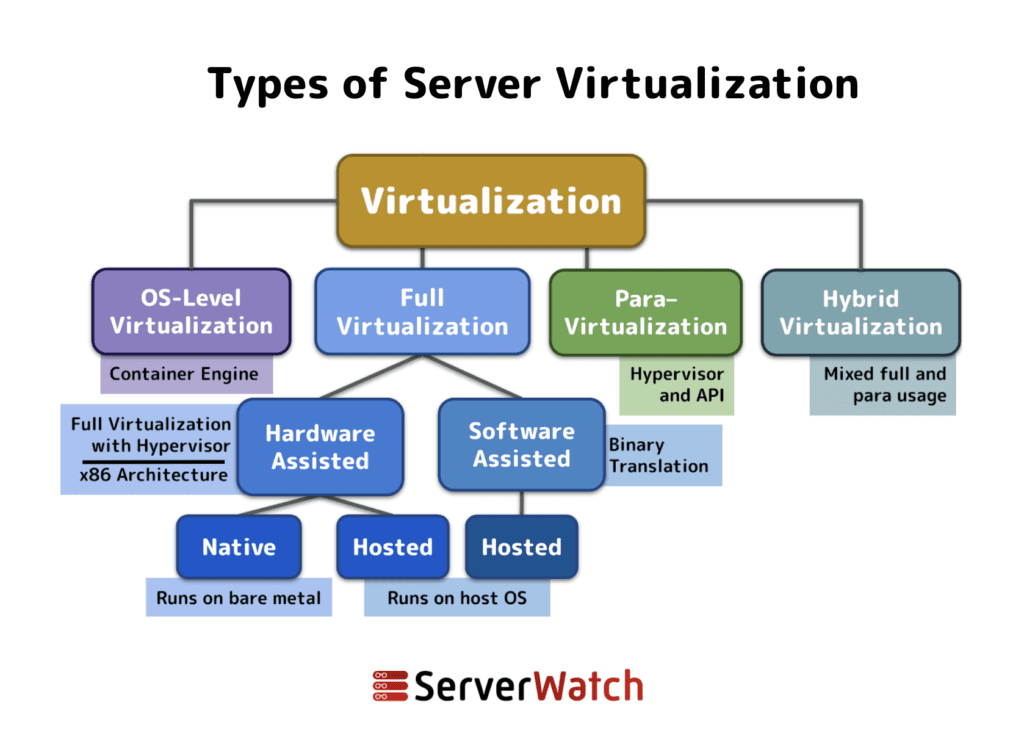Virtual servers have the same capabilities as a physical server, but not the underlying physical machinery. A physical server can create multiple, separate virtual servers with a hypervisor or container engine using virtualization technology, and the instances share physical server resources like CPU and memory.
Not long ago, some feared a future of bustling data centers covering the globe. While that sounds hyperbolic, spatial considerations have always been a critical part of any data center or server room. Thanks to virtualization, the expansion of physical infrastructure slowed in the last decade.
As more organizations reap the benefits of virtualization, virtual servers are already becoming a critical component of the modern hybrid ecosystem.
This article looks at the pros and cons of virtual servers, how to implement virtualization in your network, and the different types of virtualization, as well as guidance for managing virtual servers.
Virtual Servers Pros and Cons
| Advantages | Disadvantages |
|---|---|
| Reduced costs | Technical management |
| Spatial optimization | Lagging performance |
| Enhanced scalability | Upfront costs |
| Backup and recovery | Less scalable |
| Technical support | Legacy applications |
| Increased workload efficiency | Finite space |
| Ease of deploying new updates | Reduced control |
Virtual Server Advantages
- Reduced costs due to decreasing power, cooling, and overhead expenses
- Spatial optimization by condensing legacy physical servers into virtual servers
- Enhanced scalability as administrators can create new virtual servers as needed
- Backup and recovery features for fast, reliable restoration
- Technical support from a virtualization provider for setup, configuration, and maintenance
- Increased workload efficiency and load balancing of network demands
- Ease of deploying new updates and software to a fleet of virtual servers
Virtual Server Disadvantages
- Technical management to create, configure, monitor, and secure virtual instances
- Lagging performance when a host’s virtual servers are at higher activity levels
- Upfront costs for purchasing the physical hosts and virtualization software licensing
- Less scalable than cloud platforms
- Legacy applications may not be compatible with virtualization
- Finite space is usually limited to a single virtual machine or multiple containers
- Reduced control relative to managing an in-house server fleet; bound to vendor SLA
See our picks for Best Server Virtualization Software of 2021.
How to Deploy Virtual Servers
Virtualization requires an abstraction layer between the server hardware and software to create multiple virtual instances on a single physical server. This capability is a few clicks away on modern computers and servers with a hypervisor or container engine.
For medium to large enterprises, administrators can strategically implement virtualization to optimize space and performance needs. At large, virtual servers are available to all at remote locations through managed colocation and private data centers. Without physically accessing the host server, a network administrator can remotely control the virtual server’s functionality.
Check out features and pricing for Red Hat Virtualization.

Types of Server Virtualization
All virtualization methods help organizations optimize physical server availability and agility. What differentiates these methods are the resources and objectives of the network undergoing virtualization.
Full Virtualization
Full virtualization employs a hypervisor to trap and emulate virtual servers. The software-assisted approach uses binary translation (BT) with direct execution to implement a hypervisor. Hardware-assisted virtualization is achievable with current x86 processors, known as a bare metal (hypervisor type 1) or hosted approach on the operating system (hypervisor type 2).
OS-Level Virtualization
OS-level virtualization is the newest methodology in this space thanks to virtualization capabilities embedded in modern operating systems. Like para-virtualization, OS-level virtual servers do not emulate the host’s hardware. With the pertinent software, the OS kernel creates separate and lightweight instances called containers. Virtualization and containerization are slightly different processes, as described here.
Para-Virtualization
Para-virtualization also uses a hypervisor, but the virtual servers do not fully emulate the physical host’s hardware. Instead, an API – typically integrated into modern servers – directly exchanges calls to host and virtual server operating systems. The resulting virtual servers recognize their environment as an extension of the host’s resources and neighboring virtual servers.
Para-virtualization vs. Full Virtualization
In general, para-virtualization is more secure and faster than full virtualization. By directly communicating with the hypervisor through the API and drivers, para-virtualization has a reputation for better performance.
When considering the migration of virtual servers, full virtualization has the advantage in portability and compatibility.
Check out features and pricing for Microsoft Hyper V Server.
Virtual Server Management
Depending on the extent of network operations virtualized, organizations must use best practices for virtual server management. From in-development applications to a fleet of microservices, network admins should create, organize, and monitor any virtual servers to maximize their impact. Alternatively, managed service providers also offer virtual server management.
Some best practices include:
- Using consistent templates for virtual servers across infrastructure
- Configuring policies to meet network cybersecurity and permissions posture
- Monitoring software to track performance and health
- Ensuring virtual server data has a backup and disaster recovery strategy
- Locking down remote access via solutions like MFA, VPN, and proxy servers
Best Server Virtualization Software
- VMware vSphere
- Red Hat Virtualization
- Proxmox VE
- Microsoft Hyper-V
- Citrix Hypervisor
- Oracle VM VirtualBox
- IBM PowerVM
- Virtuozzo
Read more about our top picks for Best Server Virtualization Software of 2021.

Virtual Server vs. Virtual Machine (VM)
Virtual servers and virtual machines (VM) are often conflated, but there is a distinction. While virtual servers are achievable in multiple ways, virtual machines are a type of virtual server that employs full virtualization. Containers, similarly, are a type of virtual server that uses OS-level virtualization.
Read more about the array of server capabilities in our Guide to Servers.

